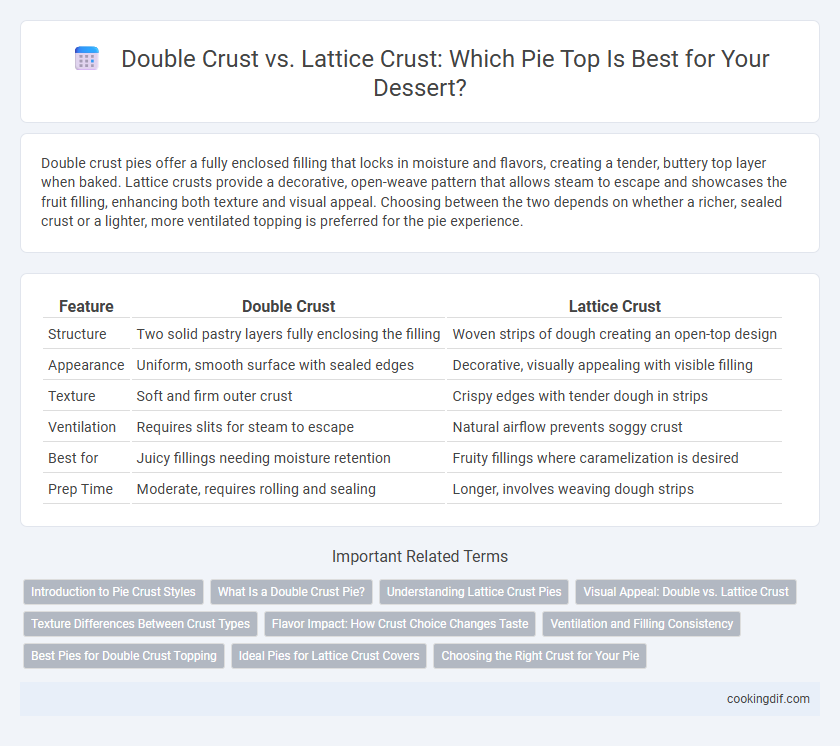Double crust pies offer a fully enclosed filling that locks in moisture and flavors, creating a tender, buttery top layer when baked. Lattice crusts provide a decorative, open-weave pattern that allows steam to escape and showcases the fruit filling, enhancing both texture and visual appeal. Choosing between the two depends on whether a richer, sealed crust or a lighter, more ventilated topping is preferred for the pie experience.
Table of Comparison
| Feature | Double Crust | Lattice Crust |
|---|---|---|
| Structure | Two solid pastry layers fully enclosing the filling | Woven strips of dough creating an open-top design |
| Appearance | Uniform, smooth surface with sealed edges | Decorative, visually appealing with visible filling |
| Texture | Soft and firm outer crust | Crispy edges with tender dough in strips |
| Ventilation | Requires slits for steam to escape | Natural airflow prevents soggy crust |
| Best for | Juicy fillings needing moisture retention | Fruity fillings where caramelization is desired |
| Prep Time | Moderate, requires rolling and sealing | Longer, involves weaving dough strips |
Introduction to Pie Crust Styles
Double crust pies feature a solid layer of dough covering the filling, providing a classic, sealed enclosure that locks in moisture and flavors. Lattice crusts consist of interwoven strips of pastry, offering a visually appealing design that allows steam to escape and the filling to thicken naturally. Each crust style impacts the texture and presentation of fruit pies, influencing the baking process and final taste experience.
What Is a Double Crust Pie?
A double crust pie features two layers of pastry dough, with the bottom crust holding the filling and the top crust sealing it completely, creating a fully enclosed pie. This style locks in moisture and flavors, making it ideal for fruit pies like apple or cherry. Compared to a lattice crust, which offers a decorative open weave and allows steam to escape, the double crust provides a thicker, more uniform texture and a traditional appearance.
Understanding Lattice Crust Pies
Lattice crust pies feature a woven pattern of dough strips that allows steam to escape while showcasing the fruit filling, creating an appealing texture and appearance. This design enhances the pie's visual appeal and produces a crisp, flaky crust that contrasts with the soft, juicy interior. Unlike double crust pies, which fully encase the filling, lattice crust pies promote even baking and prevent sogginess by balancing moisture and airflow.
Visual Appeal: Double vs. Lattice Crust
Double crust pies offer a classic, uniform golden-brown top that appeals with its smooth, enclosed appearance, highlighting the pie's traditional charm. Lattice crusts create an intricate, woven pattern that exposes the filling beneath, enhancing the pie's visual complexity and allowing steam to escape, which contributes to a glossy, caramelized finish. The choice between double and lattice crusts ultimately influences the pie's aesthetic presentation, with double crusts emphasizing simplicity and fullness, while lattice crusts showcase texture and the vibrant filling.
Texture Differences Between Crust Types
Double crust pies offer a dense, flaky texture that provides substantial structure and a satisfying crunch with each bite. Lattice crusts feature an open, woven design that creates a lighter, crispier texture allowing steam to escape, resulting in a less soggy filling. The choice between double crust and lattice affects not only the pie's appearance but also the contrast between tender filling and crust texture.
Flavor Impact: How Crust Choice Changes Taste
Double crust pies offer a rich, buttery flavor with a tender, flaky texture that complements the filling by sealing in moisture and enhancing overall sweetness. Lattice crusts provide a lighter, more delicate taste with a subtly crisp bite, allowing the fruit filling's natural tartness and juiciness to shine through. Choosing between a double crust and lattice crust directly influences the balance of sweetness, texture, and flavor intensity in every bite.
Ventilation and Filling Consistency
Double crust pies provide a sealed top that traps steam, helping fillings cook evenly while maintaining moisture, but they may limit ventilation, sometimes causing soggier fillings. Lattice crusts offer superior ventilation with open spaces that allow steam to escape, which helps prevent a soggy filling and enhances texture consistency by balancing moisture release. Choosing between double and lattice crusts depends on the desired filling type and moisture control, with lattice crusts favored for fruit pies needing better evaporation and double crusts suited for custard or cream fillings needing moisture retention.
Best Pies for Double Crust Topping
Double crust toppings provide a fully sealed surface ideal for fruit pies like apple, cherry, and peach, locking in moisture and creating a golden, flaky exterior. This crust style supports sweet and savory fillings, offering protection against spills and ensuring even baking. Pies such as classic apple, berry medley, and chicken pot pie perform best with a double crust, enhancing both texture and flavor retention.
Ideal Pies for Lattice Crust Covers
Lattice crust covers are ideal for fruit pies like apple, cherry, and berry because their open design allows steam to escape, preventing sogginess and ensuring a perfectly baked filling. This type of crust also enhances the presentation by showcasing the vibrant colors and textures of the fruit underneath. Double crust covers offer a fully sealed top, better suited for cream pies or thicker fillings that require longer baking times without drying out.
Choosing the Right Crust for Your Pie
Choosing the right crust for your pie depends on the desired texture and presentation; double crust pies provide a fully enclosed, flaky, and tender crust that seals in juices, making them ideal for fruit fillings like apple or cherry. Lattice crusts offer a visually appealing, woven pattern that allows steam to escape, resulting in a slightly firmer top and a more pronounced fruit aroma. Both crust types require well-chilled dough, but lattice crusts benefit from thicker strips to prevent breakage during baking.
Double crust vs lattice crust for covering pies Infographic

 cookingdif.com
cookingdif.com